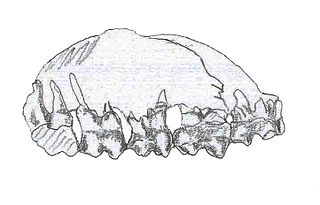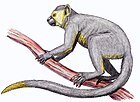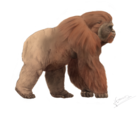
Homunculus is an extinct genus of New World monkey that lived in Patagonia during the Miocene. Two species are known: Homunculus patagonicus and Homunculus vizcainoi, which are known from material found in the Santa Cruz Formation in the far south of Argentina.

The genus Apidium is that of at least three extinct primates living in the early Oligocene, from 30 to 28 million years ago. Apidium fossils are common in the Fayoum deposits of Egypt. Fossils of the earlier species, Apidium moustafai, are rare; fossils of the later species Apidium phiomense are fairly common.

Paralouatta is a platyrrhine genus that currently contains two extinct species of small primates that lived on the island of Cuba.
Rooneyia viejaensis is a relatively small primate belonging to the extinct monotypic genus Rooneyia. Rooneyia viejaensis is known from the North American Eocene of the Sierra Vieja of West Texas; the species is only known from the type specimen. The lack of additional fossils at this time makes it difficult to hypothesize where and how Rooneyia may have evolved. The minimal wear upon the molar teeth of the specimen has led to the assumption that the type specimen is that of a young adult. Rooneyia does not consistently fall within any one group of fossil or extant primates.
Acrecebus is a prehistoric cebid monkey from the Late Miocene Solimões Formation of Acre State, Brazil and Bolivia. The only species known is A. fraileyi. This genus is closely related to the genus Cebus.
Solimoea acrensis is a prehistoric ateline monkey from the Late Miocene Solimões Formation of Brazil. It is the only known species of the genus Solimoea.
Parapithecidae is an now extinct family of primates which lived in the Eocene and Oligocene periods in Egypt. Eocene fossils from Myanmar are sometimes included in the family in addition. They showed certain similarities in dentition to Condylarthra, but had short faces and jaws shaped like those of tarsiers. They are part of the superfamily Parapithecoidea, perhaps equally related to Ceboidea and Cercopithecoidea plus Hominoidea - but the placement of Parapithecoidea is substantially uncertain.
Nuciruptor is an extinct genus of New World monkeys from the Middle Miocene. Its remains have been found at the Konzentrat-Lagerstätte of La Venta in the Honda Group of Colombia. The type species is N. rubricae.

Colombitherium is an extinct mammal from Late Eocene Colombia. It has originally been assigned to the order Pyrotheria and the family Colombitheriidae, although a later detailed analysis of the fossil questions that classification. A fossil jawbone of approximately 9 centimetres (3.5 in) length of Colombitherium has been found by Texas Petroleum in 1945, in the Upper Eocene strata of the middle Gualanday Group in the department of Tolima, Central Ranges of the Colombian Andes.

Cebupithecia is an extinct genus of New World monkeys from the Middle Miocene. Its remains have been found at the Konzentrat-Lagerstätte of La Venta in the Honda Group of Colombia. The type species is C. sarmientoi.
Lagonimico is an extinct genus of New World monkeys from the Middle Miocene. Its remains have been found at the Konzentrat-Lagerstätte of La Venta in the Honda Group of Colombia. The type species is Lagonimico conclucatus.
Micodon is an extinct genus of New World monkeys from the Middle Miocene. Its remains have been found at the Konzentrat-Lagerstätte of La Venta in the Honda Group of Colombia. The type species is M. kiotensis, a very small monkey among the New World species.
Miocallicebus is an extinct genus of New World monkeys from the Middle Miocene. Its remains have been found at the Konzentrat-Lagerstätte of La Venta in the Honda Group of Colombia. The type species is Miocallicebus villaviejai.
Mohanamico is an extinct genus of New World monkeys from the Middle Miocene. Its remains have been found at the Konzentrat-Lagerstätte of La Venta in the Honda Group of Colombia. The type species is M. hershkovitzi. Due to the relatively few material found of Mohanamico, the placement of the genus is not certain and four possible families have been proposed by different authors, Atelidae, Callitrichidae, Pitheciidae or Aotidae.
Patasola is an extinct genus of New World monkeys from the Middle Miocene. Its remains have been found at the Konzentrat-Lagerstätte of La Venta in the Honda Group of Colombia. The type species is Patasola magdalenae.
Saimiri annectens, originally described as Laventiana annectens and later as Neosaimiri annectens, is an extinct species of New World monkey in the genus Saimiri from the Middle Miocene. Its remains have been found at the Konzentrat-Lagerstätte of La Venta in the Honda Group of Colombia.
Saimiri fieldsi is an extinct species of New World monkey in the genus Saimiri from the Middle Miocene. Its remains have been found at the Konzentrat-Lagerstätte of La Venta in the Honda Group of Colombia.
Canaanimico is an extinct genus of medium-sized New World monkeys from the Late Oligocene fossiliferous fluvio-lacustrine Chambira Formation of the Ucayali Basin in Amazonian Peru. The genus was described by Marivaux et al. in 2016 and the type species is C. amazonensis.








